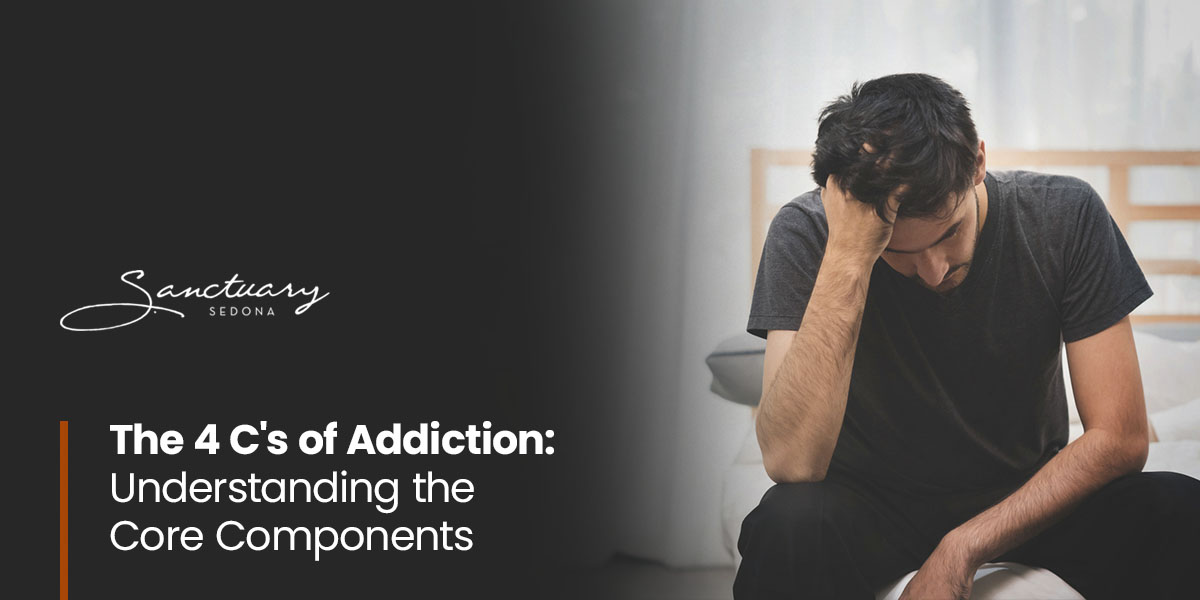Addiction is a condition that affects a person’s behaviors, thoughts and feelings. It is characterized by compulsions, cravings, a loss of control and negative consequences. These components are known as the Four C’s of Addiction, a framework that illustrates addiction is not a lack of willpower or a moral failing. Instead, it is a complex interplay of factors requiring compassionate, comprehensive care.
What Are the 4 C’s of Addiction?
The Four C’s of Addiction define the fundamental aspects of addiction and substance use disorders (SUDs) and serve as a valuable tool for identifying whether someone is living with this condition.
1. Compulsions
Addiction compulsions are defined as an overwhelming urge to engage in addictive behavior, regardless of its harmful impact. This can manifest as:
- Experiencing persistent thoughts about the behavior.
- Spending a significant amount of time and effort seeking, engaging in, and recovering from the effects of the behavior.
- Disregarding relationships and responsibilities due to the addiction.
Compulsive behavior in an SUD, such as alcohol addiction, can look like prioritizing a night of heavy drinking, even if it interferes with one’s duties the following day. In the context of a behavioral addiction like gambling, behaving compulsively may include using funds intended for essential bills to place a risky bet.
2. Cravings
Cravings are powerful desires to use substances. While these desires are characteristic of SUDs, they can also exist in behavioral addictions.
Addiction cravings are usually caused by triggers, which act as reminders of feelings, thoughts or memories associated with using that substance or engaging in a specific activity. Everyone’s triggers are different and can include:
- Environmental cues: These are people, places and things that someone might associate with their addiction.
- Emotional states: Anxiety, sadness and boredom can be triggers, especially if substances or activities were used as coping mechanisms.
- Physical sensations: Cravings can be triggered by the desire to alleviate physical discomfort, such as withdrawal symptoms.
For many people, these intense cravings are a significant factor contributing to their return to a harmful substance or activity.
3. Control
Addiction impacts the brain’s ability to assess consequences and regulate behavior, affecting the circuits responsible for self-control. It also hijacks the brain’s reward system, which reinforces behaviors necessary to survive, such as eating.
Addictive substances like opioids and cocaine cause a surge of dopamine that is 10 times higher than natural rewards, leading to intense feelings of euphoria and pleasure. The brain remembers this surge, associates it with the addictive substance or behavior, and encourages the desire to repeat the experience.
While addiction is often seen as a loss of control, it’s more accurately understood as a condition that compromises self-control through repeated use. These effects on the brain are why those living with a SUD or behavioral addiction often find it challenging to:
- Restrict their use of a substance or limit their participation in certain activities.
- Stop using a substance or participating in harmful behaviors.
- Make rational decisions about their addiction.
4. Consequences
As addiction develops, the acts of seeking and using become the primary focus, often overshadowing other priorities. The consequences of addiction can be significant, including:
- Physical: Repeated substance use can damage the body, from weakening the immune system to harming vital organs. An overdose is also a risk, causing uncomfortable or life-threatening symptoms.
- Mental: Addiction can cause emotional instability, heightened irritability and feelings of hopelessness. Taking substances can also worsen preexisting mental health symptoms.
- Interpersonal: Personality changes related to addiction can strain relationships, break trust and result in conflict. This can lead to lost contact with friends and family, isolating individuals.
- Financial: Addictive behaviors can interfere with work responsibilities, potentially leading to job loss. Regularly purchasing a drug or engaging in behaviors like gambling can be expensive, creating a financial burden and even debt.
- Legal: Possession of illicit substances like cocaine and heroin can result in imprisonment. Additionally, individuals may resort to criminal activity, such as stealing, to fund their addiction.
These consequences can be severe and may even endanger lives. There are more than 3 million deaths annually due to the use of alcohol or drugs, often as a result of chronic diseases, injuries related to car accidents, interpersonal violence and self-harm.
The Interplay of the 4 C’s
The four C’s are closely intertwined, with each component reinforcing and interacting with the others. The cycle usually starts with a craving, fueling the compulsion to use a substance. As addiction impairs self-control, these compulsions are hard to resist, even when the person wants to stop.
As a result, the person acts on the compulsions, often leading to various negative consequences. Experiencing shame or guilt in these situations is common, but the cycle often continues despite their substance use impacting their relationships, health and finances.
The challenging emotions arising from these consequences may increase cravings, as many substances are used as a coping mechanism. This can create a pattern of using to relieve this discomfort, further perpetuating the cycle.
Overcoming the 4 C’s
If someone exhibits all four C’s, it could indicate the presence of an addiction. Professional support is essential to begin the road to recovery. Recognizing the complexity of this condition, treatment and recovery programs address each component. Recovery typically involves:
- Learning how to manage triggers and cravings.
- Developing positive habits to replace compulsive behaviors.
- Healing from the physical, mental and social consequences.
- Taking back control through sobriety and making empowered decisions.
Support groups like Narcotics Anonymous (NA) or Alcoholics Anonymous (AA) are two standardized 12-step programs that are typically recommended as addiction treatment. These programs offer social support to those in recovery, creating a sense of community that can reduce isolation. They also focus on themes like acceptance and surrender, which can be beneficial in dealing with feelings of guilt and shame.
However, AA and NA aren’t effective for everyone. If 12-step programs haven’t worked for you or your loved one, it doesn’t mean hope is lost. Recovery is a personal process, and there are many approaches to healing. The Sanctuary at Sedona can guide you in finding what works best. Some evidence-based practices that have helped others overcome the four Cs include:
Therapy
Therapies like cognitive behavioral therapy (CBT) can help individuals identify negative behaviors and thoughts that might be contributing to their addiction. This can help them avoid and cope with scenarios in which they’re at risk of using, ultimately empowering them to navigate cravings and compulsions.
Medication
Medications can be vital in supporting recovery at different stages. Some medications help alleviate emotional and physical symptoms like anxiety and restlessness, which may make it easier to stop using. Others help the brain adapt to the absence of substances, which can reduce cravings and help individuals focus on other treatments.
We also administer various IV treatments to help the body and brain heal from the negative impact of addiction.
Mindfulness and Meditation
Mindful practices like meditation and yoga can rewire the brain’s reward centers. By offering fulfilling alternatives to substance use, you or your loved one can develop healthier habits.
When used alongside therapies like CBT, these practices can also help people foster greater awareness of their thoughts, emotions and feelings. This can promote better decision-making, encouraging them to consider their actions when faced with cravings and compulsions that might lead to relapse.
Address the Four C’s With The Sanctuary at Sedona
Discover your unique path to recovery and overcome the four C’s in the tranquil setting of Sedona, Arizona. The Sanctuary is a non-12-step treatment center that takes an integrative, holistic approach to addiction. We welcome anyone facing SUDs, depression, anxiety or trauma.
At our 22-acre campus, you’ll enjoy private luxury accommodations and delicious gourmet food. But what really sets us apart is our focus on helping you discover and heal from the root trauma driving your desire to use substances. Beyond treating the addiction, we treat the whole person.
Contact us today to learn more about our science-based recovery program and treatments.


